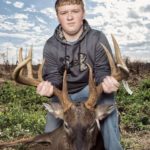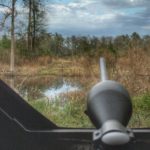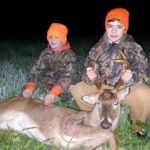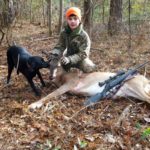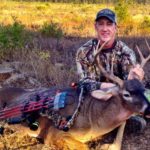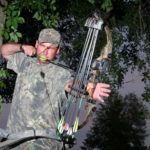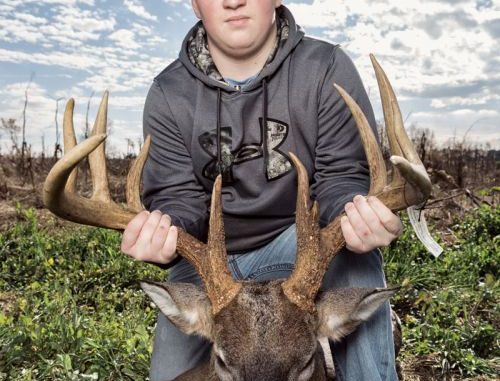
If you know there are deer on your property but you strike out time and time again, these hunters know the perfect solution. And it’s so easy you’ll kick yourself for not thinking of it.
For about 10 years, I haven’t been able to shake the feeling that I was doing something wrong.
It didn’t matter how many food plots I planted, how many mineral sites I created or how many piles of corn I put out, our deer-hunting success was marginal — at best.
The deer were there; I could see them every time I pulled a camera card.
But when we entered the woods, I just had this sneaking suspicion the deer knew we were there.
We killed a few does over the years — even a small spike or two — but I never could get past the knowledge that to kill deer you have to see deer.
My son Matthew used to give me the business toward the end of just about every hunt because all his friends were posting pictures on Instagram and SnapChat of all the deer they were seeing.
And, in the immediate world of social media that reveals just how good your friends have it when your life stinks at the moment, that’s not good.
I had another sneaking feeling that he was about ready to give up on deer hunting.
Two years ago, a right of way was cut right through the middle of a 2-year-old clear cut on our property. It was supposed to provide access to a parcel of land behind ours that was up for sale.
The lane crossed two sloughs that run the width of our property — sloughs we crossed every time we headed to the stands bordering our plots on the other side.
That same year, I started stopping at the second slough. Although I didn’t connect with a deer that year, I saw enough to know that they used these sloughs as travel corridors.
Several scrapes, large hookings on several big tulip poplar trees and a close encounter with the biggest buck I had ever seen from the stand led me to figure out a better way to hunt the following season.
Last year, I decided to hunt the abandoned right of way by setting up a ground blind on the south side of the first slough and focus on the wide lane that ran from the first slough to the second.
My goal was to only cross the sloughs to put out corn and — hopefully — retrieve dead deer.
Rather than hunt the middle of my land like I had been doing for years, I would be hunting the edges and see if I could draw the deer to me.
Long story short, my son killed his first buck last season, a nice 6-point he dropped in its tracks, and my youngest nephew Zach killed a big 7-point only minutes after his girlfriend Faith killed a big doe.
On one hunt I made by myself, I counted 14 deer — four of which were bucks ranging from a yearling spike to a tall 5-point that showed up crossing in front of my ground blind directly on the other side of the slough.
This was the kind of action we had been wishing for all along.
And the only thing we did different was not cross those sloughs.
Looking back, I firmly believe that every time we crossed those sloughs to hunt our food plots, we put every deer on the alert. That’s why our deer sightings were so low and our kills rare to nonexistent.
Come to find out, several people I talked with after the fact told me they could have saved me a lot of frustration if I had only asked them about it earlier.
Stephen Chatman, who owns the K&S Archery section of H&H Sporting Goods in Franklinton, said he never goes into the middle of his property unless absolutely necessary.
“I stick to the edges and travel multiple trails I’ve cut on the outskirts of my property,” Chatman said. “I feed them and feed them and feed them, and let them comfortably come to me.
“If I go in there and put my scent all through the woods, they’re going to know something’s up just like they knew when you were in your woods.”
And Chatman hunts only with a bow, so he has to attract them pretty close to the stands on the periphery of his property.
Avid North Louisiana deer hunter Curtis Simpson also hunts only with a bow. But rather than just go out and hunt whatever happens to walk by, Simpson targets specific big bucks.
Being successful means he has to be patient.
“When you’re hunting a big buck that you know is using your place, you can’t just go barreling in there on him and set up just a few yards from his bedding area,” Simpson said. “I learned a long time ago that I have a better chance of killing whatever buck I’m hunting if I can get him to come to me before I give up and finally go in after him.”
Experience taught both hunters that the best way to kill deer is to hunt deer that have no idea that there is a human being anywhere around.
Looking back at what was happening to me the last 10 years, all the warning signs were there, but I was too stupid — ignorant, prideful, take your pick — to realize what was going on.
There was that time when several deer sniffed me out and blew at me from way down the slough as I left my stand right at dark.
Then there was the time I jumped a pile of deer standing right in the middle of the slough I had to cross to get back home.
And I can’t tell you how many times I sat in the stand with the weird feeling that deer were behind me the whole time and would never come out in the plot because they sensed my presence and took the long way around.
“Just like you could probably walk through your house at night during a power outage because you know where everything is, deer know everything about their home territories, and they know when something is out of place,” Simpson said. “And when they sense something is out of place, they don’t act like they do when nothing is wrong.”
That just about summed up my hunting experience for the last 10 years. When I wasn’t in the woods, deer seemingly had parties right in front of my stands during shooting hours, as evidenced by all the daylight trail-cam pictures I used to salivate over.
Every time I crossed the slough to get to my stand, however, I was leaving all the evidence deer needed to lie low until I left.
“I don’t care where you walk in or how careful you are, deer are going to scent you if you cross their travel routes,” Simpson said. “A while back I had some roads that I didn’t maintain very well, and all the weeds would rub against me. I know for a fact that deer would start blowing when they got to where I crossed.
“That’s when it hit me that I needed to be hunting the edges.”
But rather than try to attract deer to where he hunts, Simpson scouts for places on the edges of his property where deer would have to eventually walk or want to be.
“If I can find a bunch of scrapes right on the edge of the woods, that’s a great spot to be,” he explained. “But I also look for pinch points, funnels and corners where deer would have to travel.”
Like Simpson, Franklinton landowner and deer hunter Mike Phelps has plenty of spots where he could hunt on the interior of his property, but he also sticks to hunting the edges as much as possible.
“I’ve got one plot in the center of my property that I will not hunt unless the conditions are absolutely perfect with no wind at all,” Phelps said. “Other than that, my kids and I hunt box stands set up on plots that we plant on the edges.”
The main reason is because the hunter believes deer can pattern him easier than he can pattern them.
“They’ll time when you enter and exit, and they generally won’t move if they know you’re in the woods,” Phelps said. “The funny thing is, though, that my deer pattern me when I walk in, but they don’t care at all about my tractor.
“Sometimes I think I ought to just drive it to the stand.”
Phelps has a creek that crosses his property, and he knows deer use it as a travel corridor. So he tries to stay out of the creek bottom whenever possible and tends to hunt spots where he knows deer will exit the creek and spread out in a plot to eat.
“I did put a plot way down in the bottom a few years ago — took me months to get it in — and I hunted it from a hang-on stand,” Phelps said. “I did see a few does and yearling bucks in there, but every time I hunted this spot I had the feeling the mature deer were skirting around me the entire time.”
But he has a couple funnels and pinch points on the edges of his property where the creek bottom narrows near a bridge. Since it’s on the edge of some big woods, Phelps and his two sons Sammy and Wyatt have been able to hunt the spot, which has turned into one of the most-productive places on his entire property.
“I killed the biggest deer I ever killed on this funnel,” Phelps said. “My son Sammy killed a big 8-point in there. My uncle killed a big 8-point in there.
“I think we’re so successful at this spot because we’re able to hunt it on the edge and the deer never even know we’re there.”
With so many people who seemed to know about hunting the edges of their properties, it didn’t surprise me when my friend Alan Williams mentioned that his daughter Siera had killed a good 6-point on some new land his family was hunting.
“Killed it right on the edge of a slough bottom,” Williams said.
He said he felt the deer were traveling this particular bottom because it was laden with hardwood trees dropping a lot of acorns and because it was easier for them to navigate since there was very little underbrush.
“But you couldn’t hunt the middle of it,” Williams explained. “The only way to kill them was for us to set up on the edges. The slough runs east to west, but we could approach it from the south and never have to cross the slough — well, at least Siera didn’t have to cross it.
“To get to my spot, I have to cross it in my Ranger. I drop her off and keep going.”
Williams sets up about 400 yards farther to the west from where his daughter hunts, and he has seen it enough times to know that she has the better of the two stand sites.
“If we’ve got a north wind, she stays down wind the entire times she’s out there,” Williams said. “The funny thing is I think deer walking the slough kind of skirt me and wind up right on top of her.”
All of these hunters have determined that hunting edges of their properties rather than barreling smack dab in the middle of them simply makes things easier on them.
“Your calls work better,” Simpson said. “Your doe-in-heat scent works better. Anything you do to attract deer is going to work better if you’re on the edges because the deer are not on edge or full alert.
“For them, it’s just another day in the woods without anything to bother them — well, at least until you let your arrow fly or pull your trigger.”
So if the property you hunt doesn’t seem to be living up to your expectations this season, try changing the way you hunt.
Rather than hunting inside out, try hunting outside in. Stick to the outside edges of your property and ease in only when necessary.
It’s amazing what you can see when they don’t know you’re there.
